(Russian Politics & Law) Guest Editor’s Introduction—Over the past quarter century Russia’s strategy within multilateral organizations has been largely driven by considerations of power, status, and entanglement. In the 1990s, president Boris Yeltsin pursued membership in “Western” institutions, such as the Council of Europe and G7, mainly for status-related reasons. He sought to position Russia as an “autonomous member” of the “European civilization”—a nation cherishing its political, economic, and cultural ties with the West yet determined to pursue an independent course in foreign policy dictated by its national interests. For geopolitical reasons, these interests were expected by the Russian leaders of the past quarter century to differ substantially from those of major Western countries.
Both Yeltsin and his successor, Vladimir Putin, believed that Russia could increase its international clout by reintegrating with other post-Soviet republics, although both leaders appeared to be under no illusion about the chances and overall expediency of reincarnating the Soviet Union. In 2003, President Putin began to advance a Russia-led economic grouping that would include Russia, Belarus, Kazakhstan, and Ukraine. While Kyiv, seeking rapprochement with and eventual membership in the European Union, pulled out of this project in the mid-2000s, Moscow never lost hope of luring Ukraine back into the customs union that Russia, Belarus, and Kazakhstan launched in 2009. Russia’s economic tug-of-war with the European Union over Ukraine led to the ouster of the Ukrainian president Viktor Yanukovich in February 2014, and to Ukraine’s ultimately inking an association agreement with the European Union (EU). […]
Read More (Introduction) © Routledge











